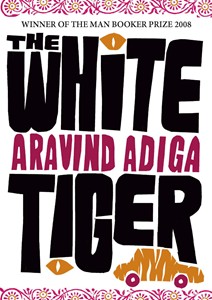 The narrative of The White Tiger takes the curious form of a one-sided correspondence between Balram Halwai, Bangalore-based entrepreneur, and the Premier of China.
The narrative of The White Tiger takes the curious form of a one-sided correspondence between Balram Halwai, Bangalore-based entrepreneur, and the Premier of China.
Halwai tells the premier that the future belongs to the “yellow man and the brown man now that our erstwhile master, the white-skinned man, has wasted himself through buggery, mobile phone usage, and drug abuse.” At first he comes across as a bit of a buffoon, but through his riffs on politics, religion and Indian society we begin to see much more complex character. It does not take us long to learn that as well as being an entrepreneur, he is also a murderer.
Halwai is a “Half-Baked Indian”, once a promising student, who had his schooling cut short at a young age when he was sent to break charcoals in a tea shop. He gains his knowledge where and when he can: from the half-understood conversations in English of his passengers; or the torn page of an old textbook used to wrap a greasy samosa.
The ubiquitous theme of The White Tiger is servitude. Halwai’s origins are in a village in “The Darkness” (the poverty-stricken plains of the Ganges) where the water buffalo is the best fed member of the family – all “hopes were concentrated in her fatness.” The villagers are serfs to the local landlords, who in turn have to grease the palms of the politicians in New Delhi. The rich retain an army of servants to cater to their every need and whim, and there are Hindi-speaking Russian prostitutes to service the landlords when they visit the city. And of course, in the call centres of Bangalore, workers rearrange their sleep patterns to provide services to US companies.
What is it that keeps everyone in their place? Halwai’s answer is the “Rooster Coop”, where caste is so ingrained that most people are as accepting of their position in life as the caged birds in the market. “The trustworthiness of servants is the basis of the whole Indian economy… Do you have something similar in China too?” he asks the Premier.
“I doubt it… or you wouldn’t need the Communist Party to shoot people and a secret police to raid their houses at night… Here in India we have no dictatorship. No secret police.
That’s because we have the coop.”
Halwai illustrates how the coop operates with a story from his village: A landlord known as the Buffalo suspected one of his servants of being complicit in the kidnapping of son by the Naxalites. The servant is tortured and killed by the Buffalo’s henchmen. But then they go after the servant’s family. His brother, his brother’s wife and his sister are all murdered. Then the family house is set on fire. Only a “freak, a pervert of nature”, writes Halwai, would be prepared to see the annihilation of his family in order to break out of the coop.
Halwai works his way up to become a driver-cum-dogsbody. His letters to the Premier capture the awkward intimacy between master and servant, and later go on to describe the turn of events that eventually lead him to take the life of his master in cold blood. This is Adiga’s first novel, and sometimes it shows – the writing sags in places – but ultimately it is driven on by the author’s desire to expose the dark side of the Indian economic “miracle”. For that, Adiga should be commended.
Halwai’s view of the Indian masses is a mixture of contempt and pity, a self-justifying, if unsurprising, outlook for a self-made entrepreneur. He is the White Tiger (Kiwis might say Tall Poppy) who had the requisite strength of character to raise himself above the swinish multitude. In a couple of passages, he describes the condition of the construction workers who build the gleaming towers of the Brave New World: fighting each other in the mob for a day’s work, and living in degraded shanty towns. But will these people remain passive victims forever? Just last month, thousands of workers rioted at the Commonwealth Games construction site in Delhi, protesting against the death of a labourer.
One more question – is Halwai right to say that China and India are poised to replace the western imperialist countries as top dogs? No doubt about it, their influence is waxing. When Bush called an international meeting in November to deal with the global financial crisis, he looked beyond the First World G-8, and instead invited the G-20, which includes the leading developing economies. Yet the greenback remains the global currency, albeit battered and bruised these days. And, as if we could forget it, militarily, the US remains the only superpower on the planet.
– Mike Kay
